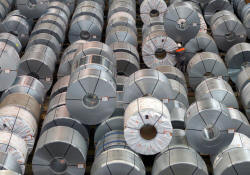German industrial orders jump on vibrant demand from
abroad
 Send a link to a friend
Send a link to a friend
 [October 06, 2017]
By Michael Nienaber [October 06, 2017]
By Michael Nienaber
BERLIN (Reuters) - German industrial orders
bounced back in August, rising more than expected on strong foreign
demand, data showed on Friday, suggesting that factories will contribute
to overall growth in Europe's largest economy in coming months.
Industrial companies registered a 3.6 percent increase in orders after
contracts for 'Made in Germany' goods fell by an upwardly revised 0.4
percent in July, data from the Economy Ministry showed.
The reading for August was the strongest monthly increase since
December. It easily beat the Reuters forecast for a 0.7 percent rise,
surpassing even the most optimistic estimate.
A data breakdown showed domestic demand rose 2.7 percent while foreign
orders jumped 4.3 percent, propelled by a 7.7 percent increase from
customers outside the euro zone - despite the recent appreciation of the
single currency.

"Orders activity further picked up recently from an already high level,"
the ministry said, adding that the positive trend was backed by good
business morale and strong output figures.
"The solid upturn in the manufacturing sector should therefore
continue," it added.
"SUMMER EXPLOSION"
ING Bank chief economist Carsten Brzeski said the "summer explosion in
new orders" was likely the result of some bulk orders. Nevertheless, the
strong August figure all of sudden made 2017 a strong year for new
orders, Brzeski said.
[to top of second column] |

An employee inspects rolls of steel at the plant of German steel
company Salzgitter AG in Salzgitter, Lower Saxony, Germany, March
21, 2012. REUTERS/Fabian Bimmer/File Photo

"Combined with strong business surveys, showing production expectations as well
as orders books close to record highs, the German industry looks all set to end
the year at maximum speed."
Bankhaus Lampe economist Alexander Krueger was a bit more cautious, saying he
doubted that the German economy could shift into an even higher gear after
already strong growth rates in the first two quarters of the year.
The German economy grew 0.7 percent on the quarter in the first three months of
the year and 0.6 percent from April to June, driven by increased household and
state spending as well as higher investment in buildings and machinery.
Leading economic institutes last week raised their growth forecast for the
German economy to 1.9 percent in 2017 and 2.0 percent in 2018. This would
translate into calendar-adjusted GDP rates of 2.2 percent and 2.1 percent
respectively.
The German government will present its updated projections for GDP growth,
employment and inflation on Wednesday.
(Reporting by Michael Nienaber; Editing by Paul Carrel and Toby Chopra)
[© 2017 Thomson Reuters. All rights
reserved.] Copyright 2017 Reuters. All rights reserved. This material may not be published,
broadcast, rewritten or redistributed.
 |